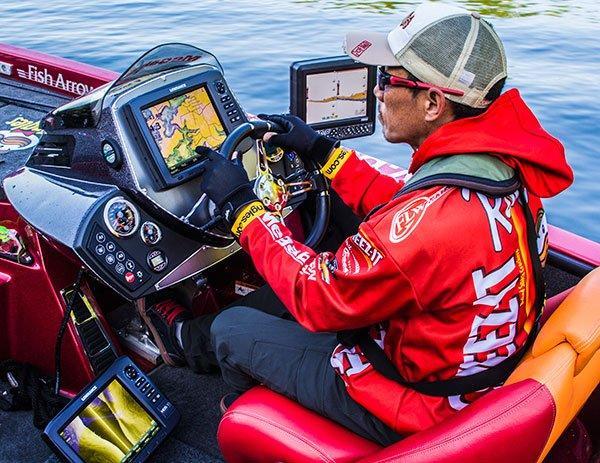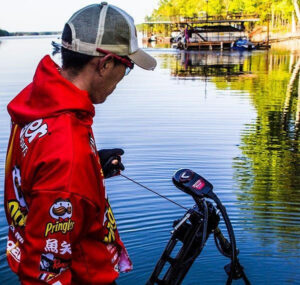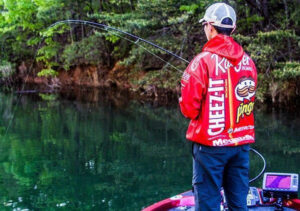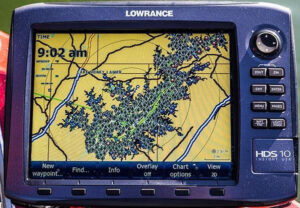As the spawn dies down in many parts of the country, you can expect the majority of bass to vacate their temporary shallow homes in search of deeper summertime dwellings. Dissecting these deep fishing spotsfor bass doesn’t always mean dragging soft plastics and staying in one spot for hours on end, however.
Cheez-It pro Shin Fukae’s ability to fish deep quickly propelled him to a recent PAA win on Lake Douglas. While many anglers fished underwater cover slowly and methodically, Fukae visited dozens of spots each day, efficiently covering key pieces of cover.
Prime targets
When the late spring water and early summer water temperatures reach the 70 to 75-degree range, Fukae begins his search for deep cover such as brush piles, rock piles, shell beds, vegetation and timber. In the early post-spawn period, deeper cover close to shallow water is essential for finding big bass. He advises, however, that depth is a relative term in this case.
“The depth of post-spawn cover you’re looking for really depends on what type of lake you’re fishing,†Fukae said. “In some shallow fisheries, a brush pile in 8 feet of water is considered deep, while in deeper, clear lakes I’ll focus on the 20-foot depth range a bit more. Either way, you want to find deep cover adjacent to spawning flats.â€
Just because the cover is in deep water doesn’t mean there will be bass present. Fukae looks for submerged cover strategically located in or around “bass highwaysâ€â€”creek and river channels bass use as travel routes to and from deep water. In addition to using these areas as natural pathways, bass will also use these areas to recover from the rigors of the spawn.
“I look for brush located in and around points, in the mouths of short pockets and creeks and in creek channel bends,†Fukae said. “It’s the path of least resistance to deeper water, making them great staging areas for early summer bass.â€
Efficiency is key
If you’ve been idling around all day looking for deep cover, it’s tempting to “camp out†when you finally find a good looking area. It’s in the right depth, it’s close to deep water and the conditions are perfect—there must be fish there, right? Fukae takes a much different approach that allows him to fish more productive areas while eliminating dead water.
“At the very most, I’ll make about 5 casts to each piece of cover without getting bit,†Fukae said. “In my opinion, the first couple of casts are simply getting the fish’s attention. If I still can’t get them to bite after a few more casts, I either change baits or move on. There’s too many fish in the lake to get caught up on a single piece of cover.â€
As he approaches submerged cover, Fukae prefers to keep his distance so he doesn’t risk spooking wary bass. This extra distance also allows him to use his trolling motor more while frequently changing his casting angles.
“Casting angles are very important—it’s what helped me win the PAA event on Lake Douglas,†Fukae said. “I make about 2 casts at each angle—to the front, the back and the sides. This gives me confidence that the fish have gotten a good look at my bait.â€
Change approach to match the conditions
Bass are fierce predators and will use deep cover as ambush points for prey, such as shad and crawfish. In windy conditions, Fukae takes advantage of their instincts by casting into the wind.
“Bass tend to face up-current when they’re positioned on deep cover,†Fukae said. “When baitfish get blown by the wind, the bass will hide in the cover and ambush them as they pass. I cast into the wind to replicate this natural occurrence so my bait will come at the bass head-on.â€
In calmer, sunny conditions, you’ll find Fukae making more precise casts to cover. Bass stay tight to cover in these situations, making accurate, deliberate casts much more important.
“I really slow down my approach when fishing in sunny conditions,†Fukae said. “The bait probably isn’t moving around as much and everything underwater is much calmer. A fast or noisy approach can seem very unnatural to bass in these situations, so make sure to slow your presentation. That doesn’t mean you need to sit on a brush pile for hours, but just make your 5 casts count.â€
Mistakes to avoid
Fishing deep cover efficiently takes a great deal of time and practice. After years of practice and catching numerous big bags with this technique, Fukae urges anglers to spend time on their electronics.
“You’ve got to idle and watch your graphs—a lot—to find productive areas,†Fukae said. “It’s going to be tough to fish deep cover quickly if you don’t have enough spots to last throughout the day. I dedicate entire days to searching for cover, and as a result I have over 1,000 pieces of deep cover marked on several fisheries. You have to give yourself options.â€
Fukae is also a staunch believer in big electronic displays. The large screens help him make better sense of the surrounding bottom composition, therefore allowing him to quickly eliminate areas if the needed factors aren’t present.
“I love my Lowrance Gen2 HDS-10 graphs,†Fukae said. “They help me key in on very small details, especially bottom composition. If your wallet—or spouse—allows you to step up to larger electronics, by all means, do it!â€
If you’ve found great looking cover on your graph, don’t get discouraged if you don’t get any bites. This happens to Fukae frequently, but he doesn’t let it fluster him. Instead, he’ll come back to the area throughout the day in hopes of catching them in a feeding period.
“Deep cover bass aren’t going to eat all day, every day,†Fukae said. “They’ll go through periodic feeding windows, making it important to keep checking on your best cover. You can fish a specific piece of cover 4 times and not get any bites, and then catch 20 pounds of fish on your fifth visit. Stay calm, have fun and you’ll hit it right if you keep trying.â€
Deep water fishing takes some getting used to, but if you spend time idling and graphing with your electronics, you’ll give yourself the ability to quickly cover deep cover. The more options you uncover, the better chance you have at running across a school of huge bass.















